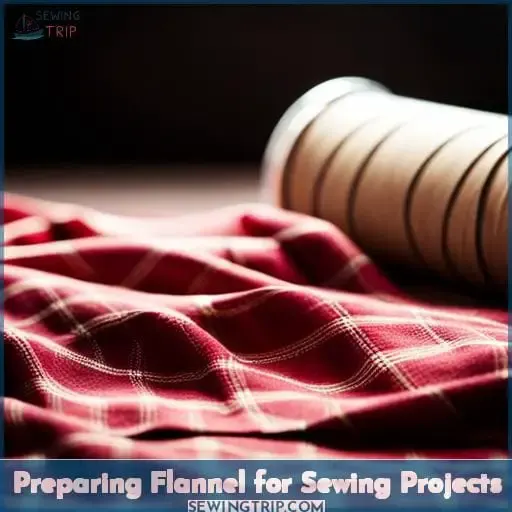This site is supported by our readers. We may earn a commission, at no cost to you, if you purchase through links.

But take heart: with care and forethought, you can tame this shifty fabric.
Mind the grains when cutting, give seams breathing room, and practice patience as flannel releases its last hidden ripples of shrinkage.
Together we’ll strategize stitching snuggly flannel creations without tears or puckers.
Now pin back those cuffs, grab your shears, and let’s get stitching!
Table Of Contents
Key Takeaways
- Prewash flannel multiple times on hot and dry on high heat to allow for shrinkage before cutting and sewing.
- Purchase extra yardage beyond pattern requirements to accommodate shrinkage.
- Press flannel with starch after prewashing to minimize stretching and distortion before cutting.
- Use a new, sharp sewing needle (like an 80/12 or 90/14) to prevent skipped stitches.
Why Does Flannel Shrink?
When working with flannel fabric, you must understand why it shrinks.
Flannel contains residual shrinkage, meaning even after washing, it can continue to shrink.
To prevent disappointment, always prewash your flannel multiple times on hot and dry on high heat before cutting and sewing.
Residual Shrinkage
Due to flannel’s loose weave, you’re left with residual shrinkage even after prewashing the fabric.
To minimize residual shrinkage:
- Wash in hot water.
- Dry on high heat.
- Repeat washing and drying multiple times.
- Allow for 5-10% shrinkage.
This removes excess fibers and allows the fabric to shrink before cutting and sewing.
However, some residual shrinkage may still occur after projects are complete.
Check if your pattern accounts for flannel shrinkage to prevent finished items from distorting.
Prewashing Flannel
To prevent excessive shrinkage and minimize the risk of distorted seams, it’s essential to prewash flannel fabric before starting any sewing project.
Immerse the fabric in hot water, then machine wash and dry on high heat.
This prewashing benefits flannel by shrinking the fabric prior to sewing, allowing you to cut accurate pattern pieces and achieve quality results without stretched seams.
With careful fabric care and quality considerations, you can overcome common flannel sewing challenges.
Buying Enough Flannel Fabric
When buying flannel for your next project, you must account for shrinkage by purchasing at least an extra quarter yard beyond what your pattern calls for.
Flannel may be narrower off the bolt than stated, so be sure to measure it prior to purchase.
Purchasing extra flannel upfront allows you room for error and materials for matching accessories later.
Allowing for Shrinkage
Your allowance for shrinkage starts with purchasing at least a quarter yard extra than measurements dictate.
Even quality flannel may shrink up to 5 percent.
Measure fabric width for accuracy claims.
Despite best care efforts per instructions, residual shrinkage lurks.
Prepare to surrender yardage to its relentless pull.
Yet deft needleworkers triumph over its entropy through foresight.
They wield nimble notions against fabric distortions, securing victory one quarter yard at a time.
The bitten yield only what the thrifty seamstress claimed in advance.
Though flannel shrinks without mercy, its coveted softness compelled, the wise take extra.
Purchasing Extra Yardage
You’re always wise to buy some extra yardage when purchasing flannel, as the fabric is known to shrink quite a bit.
Consider allowing at least one extra quarter yard per two to three yards purchased to accommodate for shrinkage.
Also factor in potential fabric width inaccuracies, as well as small cutting or sewing errors.
Having surplus flannel on hand saves time re-purchasing if your project ends up shorter than expected after washing.
When buying quality flannel, the extra cost is worthwhile to yield professional results without frustration.
Preparing Flannel for Sewing Projects
Before starting any flannel project, you’ll want to pre-wash and dry the fabric properly.
Use hot water, dry on high heat, and repeat this process 2-3 times to maximize shrinkage.
Applying spray starch and pressing the flannel will also help minimize stretching and distortion while sewing.
Washing and Drying Flannel
One key step in preparing flannel for sewing is to wash and dry your flannel fabric multiple times before cutting and sewing to minimize residual shrinkage later on.
Doing so allows the fabric to shrink before the garment is constructed.
Check that your washed flannel remains true to the expected width needed.
Occasionally, additional shrinkage happens even after initial washing.
Have extra yardage on hand for such instances.
Proper pre-treatment saves headaches when working with temperamental fabrics like flannel.
Using Spray Starch
The use of spray starch when preparing flannel can help control stretching and distortion of the fabric.
When working with delicate fabrics like flannel, apply spray starch to the wrong side before ironing to stiffen and prevent wrinkles without risking damage.
Using starch allows crisp cuts and prevents fraying edges.
For best flannel preparation, fully prewash and dry prior to a light starch application.
Techniques for Cutting Flannel
Four smart tips can help you cut flannel fabric cleanly and accurately:
- Use very sharp scissors or a rotary cutter with a fresh blade to prevent fraying edges.
- Apply spray starch to the wrong side of the flannel before cutting to stabilize the fabric.
- As you cut, take care to precisely follow pattern lines so pieces match up properly.
- Leave at least a 1⁄2” seam allowance, or serge edges immediately after cutting.
With sharp cutting tools, starch application, rotary precision, and ample seam allowances, you’ll achieve smooth flannel edges that neatly piece together during sewing.
Sewing Machine Tips for Flannel
When working with flannel fabric, you’ll want to:
- Install a new sharp needle, like an 80/12 or 90/14, in your machine before sewing.
- Use an appropriate stitch type, like a zigzag or stretch stitch, to allow give in the woven fabric.
The right needle and stitch combo helps prevent skipped stitches and thread breaks when sewing tricky materials like flannel.
Needle Size
8 Tips to Fix Common Issues When Working With Flannel:
- Use a sharp needle in a larger size like 90/14 when sewing flannel fabric.
- The thicker needle helps prevent skipped stitches due to the loft and texture of flannel.
- Choose needles specifically designed for heavyweight fabrics whenever working with flannel to achieve smooth seaming and prevent snags in the fabric’s soft surface.
Stitch Type
Set your sewing machine to use a zigzag or stretch stitch when working with flannel to allow give in the seams. This stitch type helps prevent seam stretching and ensures that your projects maintain their shape over time.
Additionally, using a walking foot can further aid in preventing stretching and ensure even feeding of the fabric through the machine.
Don’t forget to regularly clean and maintain your bobbin for optimal stitching results.
Walking Foot Benefits, Needle Choices, Starching Tips, Seam Stretching, Bobbin Maintenance
Preventing Stretched Seams
When working with flannel, stretched seams are a common frustration.
Equipping your machine with a walking foot can help prevent this issue.
Carefully handling the fabric can also help prevent stretched seams.
We’ll examine using these two methods to keep your flannel projects wrinkle-free.
Walking Foot
Using a walking foot on your sewing machine can help prevent the flannel’s seams from stretching.
The walking foot’s built-in feed dogs grip and advance the fabric precisely, ensuring the layers remain flat and taut for quilting ease.
Though flannel challenges precision, a walking foot provides control.
Achieving piecing and fabric handling mastery comes with experience.
Try wax-free tracing paper for flannel quilting ideas.
Fabric Handling
When working with flannel, you’ll want to handle the fabric carefully to prevent stretched seams.
Gently pull the fabric taut when cutting to avoid distortion.
Use pins generously when assembling pieces to minimize shifting.
Consider basting first for complicated seams.
Press lightly.
Allow projects to hang before final pressing to let seams relax.
Take care not to tug or skew the fabric unnecessarily during handling and sewing.
Proper precautions will help the flannel retain its shape and drape beautifully.
Binding Flannel Quilts
You’ll need to add extra width to flannel binding to account for potential shrinkage when finishing your quilt.
Here are 4 creative binding techniques for your flannel quilts:
- Add wool binding for a cozy feel along the edges.
Consider a chunky braided look or improvise your own irregular shaped binding.
- Finish the binding seam with a visible topstitch using a contrasting thread.
Play with different stitch lengths for texture.
- Incorporate ribbons, rick rack, or lace along the flannel binding seam for a decorative touch.
Get creative with your embellishments!
- Wrap cotton backing fabric to the front, mitering the corners for a neatly folded binding.
This gives a subtly polished finish.
Experiment with binding techniques to make your flannel quilt distinctly yours.
Don’t be afraid to try inventive edges to embrace the charming character of flannel.
With some clever tricks, you can finesse potential issues when quilting with this fabric.
Cleaning Lint Out After Sewing Flannel
After binding that fluffy flannel quilt of yours, you’ll want to clean out the lint that’s inevitably built up inside your sewing machine.
Flannel fabric sheds lint easily, which can clog up the inner mechanisms over time.
Make it a habit to use compressed air to blast away fuzz, carefully cleaning the bobbin case, feed dogs, tension discs, and any other nooks where lint gets trapped.
Check the needle plate and bobbin area too.
For hard-to-reach spots, use a soft brush.
Maintaining your machine prevents skipped stitches or thread breaks mid-project.
We quilters know the hassles of sewing challenges and proper fabric care.
Share your best maintenance tricks in the comments to help our community learn clever lint removal methods.
Keeping things clean allows us all to enjoy flannel quilting worry-free!
Frequently Asked Questions (FAQs)
How can I prevent my flannel fabric from fraying?
Serge or overlock your seams to prevent fraying.
If you don’t have a serger, use a small zigzag stitch close to the raw edge instead.
Make sure your machine is set at a shorter stitch length when sewing flannel to help.
Pressing with steam also helps seal the edges.
What needles and threads work best for sewing flannel?
Select a denim or microtex needle and polyester thread for seam strength through flannel’s fuzzy fibers.
The sharp point and strength resist breakage, while poly thread won’t lose strength from heat during repeated washings.
My flannel fabric got holes/runs when I had to rip seams. How can I avoid this next time?
Ripping flannel seams can easily snag threads, so handle it gently.
Next time, use a seam ripper and go slowly. Lifting the flannel as you rip prevents excess tugging on threads.
A little fray preventer along the seam line helps too.
Why does my flannel fabric look distorted or develop a weird texture after washing?
Sometimes a flannel’s loose weave distorts when laundered.
Shrinking may also create uneven textures.
Prewashing and drying twice minimizes distortion.
The corners of my flannel binding tend to stick up. What can I do to get a smooth binding?
Starch the binding well before sewing.
Clip binding seam allowances at corners.
Miter corners precisely.
Press binding away from quilt before turning and topstitching.
Check that corners are square as you sew.
Conclusion
Though flannel may seem finicky, friend, with a bit of care, you’ll be stitching cozy creations in no time.
Simply wash and press your fabric beforehand.
Give those seams room to breathe.
Take it slow—flannel can’t be rushed.
Most problems sewing flannels arise when we skip these prep steps.
Follow this advice, and that shifty fabric will give you snuggly blankets and soft flannels without frustration.
Now get stitching, and show that flannel who’s boss!














